Related Reader's Guides
Related Tibetan Lineages: Jonang | Shangpa Kagyu | Kagyu
Guides to Other Important Tibetan Buddhist Figures: Jamgon Kongtrul | Longchenpa | Tsongkhapa | Jigme Lingpa | Patrul Rinpoche
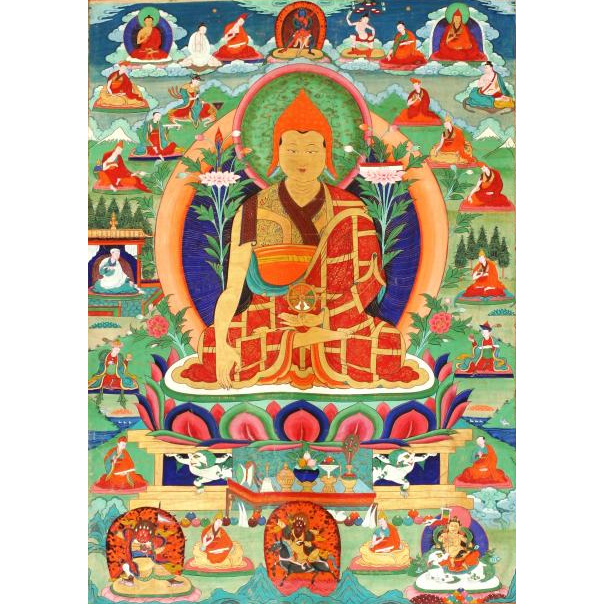

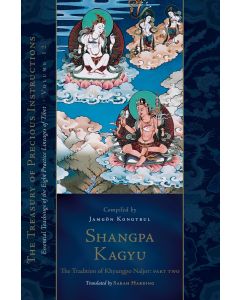
By Jamgon Kongtrul Lodro Taye
Translated by Sarah Harding
Contributions by Taranatha
Contributions by Atisha
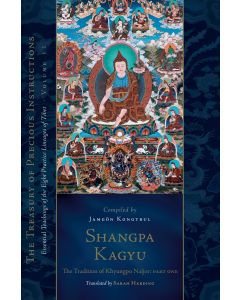
By Jamgon Kongtrul Lodro Taye
Translated by Sarah Harding
Contributions by Taranatha
Contributions by Atisha
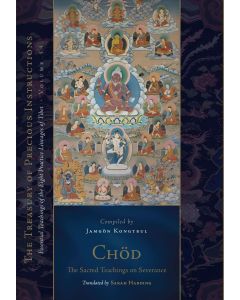
By Jamgon Kongtrul Lodro Taye
Translated by Sarah Harding
Contributions by Rangjung Dorje
Contributions by Taranatha
Contributions by Karma Chagme
Contributions by The Fourteenth Karmapa, Thekchok Dorje
Foreword by The Seventeenth Karmapa
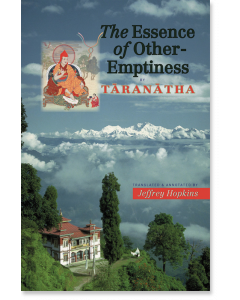
By Taranatha
Translated by Jeffrey Hopkins
Translated by Lama Lodro Namgyel
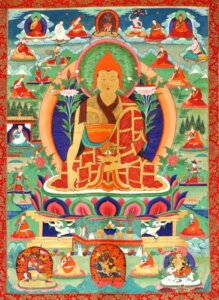
Taranatha: A Guide for Readers
Related Reader's Guides
Related Tibetan Lineages: Jonang | Shangpa Kagyu | Kagyu
Guides to Other Important Tibetan Buddhist Figures: Jamgon Kongtrul | Longchenpa | Tsongkhapa | Jigme Lingpa | Patrul Rinpoche
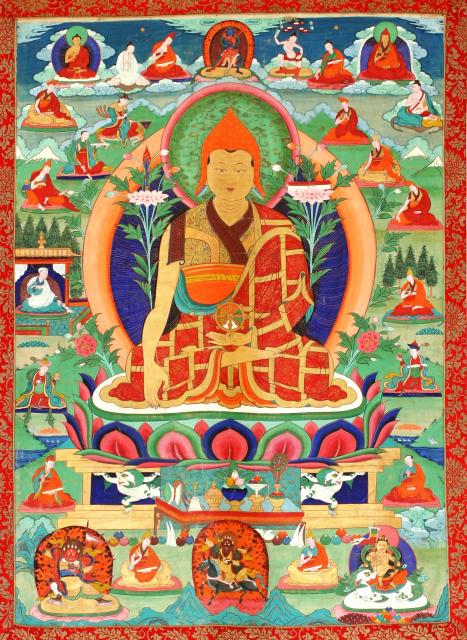
Jetsun Taranatha (1575-1634), also known as Kungpa Nyingpo, was a great master of the Jonang tradition of Tibetan Buddhism. He is widely known for his History of Buddhism in India. His name, Taranatha, is of Indian origin and is said to have been given to him by a great Indian adept in a dream.
Taranatha studied with many great masters across different traditions including the Sakya tradition of Lamdré (Path with Its Result), and the Six Yoga of Mahamudra. However, he primarily sought to uphold the teachings of the Jonang tradition, as it was detailed by Dolpopa Sherab Gyaltsen, the forefather of the Jonang tradition. In that regard, he received the transmission of the Kalachakra teachings and the esoteric instructions of the sixfold yoga according to the Jonang tradition as well as the collected writings of Dolpopa. When he was fourteen he became a close disciple of the Indian adept Buddhagupta-natha and received several tantric initiations and esoteric teachings.
In 1588 Taranatha was enthroned at Jonang Monastery. Throughout his lifetime he took up the responsibility of preserving and clarifying the teachings of Dolpopa, defending his view of Shentong (other emptiness), and accurately preserving the correct interpretation of the Jonang lineage. Many of Taranatha's translations are included in the Kangyur and Tengyur (the Tibetan canonical collection).
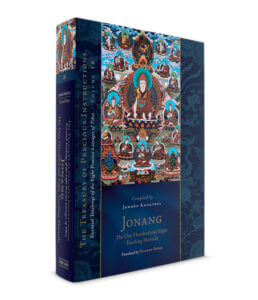
To learn more about the books in the Treasury of Precious Instructions see our Guide to the Treasury of Precious Instructionswhich includes a downloadable catalog, videos from the translators, and more.
Jonang: The One Hundred and Eight Teaching Manuals
$39.95 - Hardcover
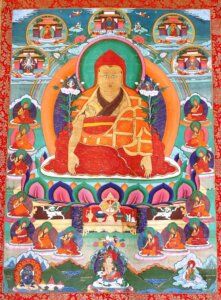
Portrait of Dolpopa Sherab Gyaltsen, courtesy of the Jonang Foundation
As a devoted practitioner of the Jonang school, Taranatha was committed to the vision and teachings of Dolpopa Sherab Gyaltsen (1292-1361).
Based largely on esoteric Buddhist knowledge from the legendary land of Shambhala, Dölpopa's insights have profoundly influenced the development of Tibetan Buddhism for more than 650 years. Dölpopa emphasized two contrasting definitions of the Buddhist theory of emptiness. He described relative phenomena as empty of self-nature, but absolute reality as only empty of other (i.e. relative) phenomena. He further identified absolute reality as the buddha nature or eternal essence present in all living beings. This view of an "emptiness of other," known in Tibetan as shentong, is Dölpopa's enduring legacy. The Buddha from Dölpo by author and translator, Cyrus Stearns, contains the only English translations of three of Dölpopa's crucial works.
His influence on Taranatha, specifically his philosophy of Shentong, Kalachakra, and the Kingdom of Shambhala, will be discussed more below.
While Taranatha was primarily a proponent of the Jonang tradition, he was also a lineage holder of the Shangpa Kagyu (a Tibetan lineage based on the teachings of the two dakinis, Niguma and Sukkasiddhi) and played a large role in preserving and clarifying the tradition. In fact, several source texts by Taranatha can be found in Volume 11 and 12 of Kongtrul's Treasury of Precious Instructions including his Five Tantras' Deities Lineage Supplication in the Shangpa Tradition in addition to other explanations of the Five Tantras specific to the Shangpa Kagyu lineage.
*Volume 11 is available now with volume 12 arriving in the fall of 2023.
Shangpa Kagyu: The Tradition of Khyungpo Naljor, Part One
$44.95 - Hardcover
Though not directly referred to in this edition, Taranatha wrote a clarifying commentary to Niguma's Six Yogas called "Yogic Exercises for Clearing away Afflictive States" indicating how deeply steeped he was in the Shangpa Kagyu tradition despite being renowned as a Jonang master.
In addition, there are two selections from Taranatha found in Volume 14 of Kongtrul's Treasury of Precious Instructions, further indicating how far his influence stretched. It is especially clear that he played a significant influence on Kongtrul, as we will see below in preserving Tibet's Buddhist traditions as well as the Shengong view of Tibetan Buddhist philosophy and practice.
Chod: The Sacred Teachings on Severance
$59.95 - Hardcover
Shentong (Tibetan) translated as "other empty," is a philosophical view from the tradition of Madhyamaka and is closely associated with the Jonang school of Tibetan Buddhism. Other emptiness entails that the ultimate truth is not empty of itself (rangtong), rather, it is empty of all other relative phenomena.
Kālachakra (Sanskrit) translated as "wheel of time" includes teachings on cosmology, philosophy, and meditative practice. Kālachakra according to the Jonang tradition and the teachings of Dolpopa blends the view of Shentong and the Kalachakra Tantric Practices and incorporates teachings from both Madhyamaka and the Five Treatise of Maitreya (a series of texts that emphasizes the view of Yogācāra).
According to Cyrus Stearn's biography of Taranatha from The Treasury of Lives, Taranatha is said to have first taught the Kalachakra Tantra having a vision upon restoring the Great Stupa originally build by Dolpopa. Stearns writes:
Just before the restoration work was finished, it is said that he had a marvelous vision one morning. The earth and sky seemed filled with countless people of all descriptions going in the same direction. He joined with them and arrived in a red, triangular valley with an incredible crystal mountain in the center. The mountain was totally filled with amazing stupas of different sizes, and in each stupa infinite buddhas and bodhisattvas were speaking back and forth about the dharma. Flowers fell from the sky like rain, and many other miraculous signs occurred. All of the people were making offerings to the crystal mountain filled with stupas, and chanting a series of verses in unison. Awestruck, Tāranātha asked about the mountain, and was told that it was the Dhānyakaṭaka Stūpa, where the Buddha is believed to have first taught the Kālacakra Tantra.
As Long as Space Endures is a collection of essays on the Kalachakra Tantra. In A Lineage History of Vajrayana and Tantric Zhentong from the Jonang Kālacakra Practice Tradition, Michael R. Sheehy discusses some of Taranatha's activities related to Kalachakra:
Tāranātha is said to have had frequent visions of Dolpopa Sherab Gyaltsen and to have visited Śambhala during his dreamtime where he would meet with the kalkī Śrīpāla. Inspired by these visionary experiences, Tāranātha was one of the most prolific authors on zhentong and the Kālacakra, second only to Dolpopa. Among his collected writings, thirty-two works are solely dedicated to various topics concerning the Kālacakra. These works range from his History of the Kālacakratantra to precise directions on how to prepare for a tantric feast (tshogs mchod), clarifications on tantric precepts (sdom pa), methods for meditation practice (sgrub thabs), and ritual techniques (cho ga) for performing the Kālacakra empowerment and associated ceremonies. Eleven of these works are dedicated to explaining the path of vajrayoga through precise introductions (ngo sprod), guidance instructions (man ngag), and responses to critical inquiries (dri lan). Included in his works on the Kālacakra are his texts Meaningful to Behold and its supplement (lhan thabs), which remain the standard Jonang instruction manuals for intensive meditation retreat on the sixfold vajrayoga.
$39.95 - Paperback
By: Alexander Berzin & Edward A. Arnold & Thupten Jinpa & Edward Henning
Visions of Shambhala
Furthermore, Taranatha is said to have had visions of the Kingdom of Shambhala, the visionary Buddha realm mentioned in the Kalachakra Tantra. Stearns writes:
Tāranātha had countless such visions during his life. For example, many times during the years 1618 and 1619 he experienced visions of the Kalapa court of the Shambhala emperors, beheld the rulers themselves, and heard their teachings. He felt that these visions were a result of his belief that the ultimate view of all sutras and tantras was zhentong Madhyamaka.
The Realm of Shambhala presents the Kalachakra Tantra’s multilayered approach to Shambhala as taught by the Tibetan Buddhist Jonang tradition. Understood to be an ancient kingdom and physical place, Shambhala is also taught to be an exalted state of mind attainable by all through practice.
Shar Khentrul Jamphel Lodrö Rinpoche goes into significant detail discussing "The Golden Age Tradition of the Jonang," including Taranatha's legacy in preserving the tradition—particularly the tradition of Dolpopa. He was so deeply connected and committed to Dolpopa's teachings that he continued having repeated visions of Dolpopa. One story in The Realm of Shambhala explains that after praying to Dolpopa, one evening he appeared to him in the form of Dharmodgata and spoke to him four lines of verse. Taranatha was awkened to great realization and in that moment acheived the view of other-emptiness. His doubts cleared away, he composed the Ornament of Other Emptiness (Tib. Shen tong umé gyen).
In Defense of Shentong
Furthermore, in an attempt to preserve the legacy and authenticity of the Jonang tradition, Taranatha set out to write a series of texts that include extensive scriptural citations, framing the Jonang tradition within the context of the Tibetan Buddhist tenent system (predominantly the four major schools of Tibetan Buddhism—Nyingma, Kagyu, Gelug, and Sakya).
Jeffry Hopkins' translation of The Essence of Other-Emptiness by Taranatha is a perfect example of how Taranatha displayed the authenticity of the Jonang tradition through a common philosophical discourse of the time.
In his introduction, Hopkins explains how the Jonang school was undergoing significant criticism, supression, as well as violence against them under the emergent Gelug tradition under the leadership of the Fifth Dalai Lama and the immediate disciples of Tsongkhapa. Taranatha, therefore, undertook the difficult task of keeping the Jonang school afloat amidst political instability in Tibet and doctrinal suppression. Thankfully their tradition survived and today it is officially recognized as the fifth living Buddhist tradition of Tibetan Buddhism.
His life and pursuit is an example of how much can be accomplished through the power of devotion and the willingness to work for what's meaningful in the face of even the severest obstacles. Even after his death in 1634, he continued inspiring Buddhist practitioners including some of the most renowned masters. As Willa Baker, author of The Wakeful Body reports,
"Taranatha’s life example so inspired Jamgon Kongtrul that he devoted three days a year in his retreat center to the celebration of Taranatha’s memory, an honor he extended to no other single lineage holder.”
The Essence of Other-Emptiness
$24.95 - Paperback
Because of his work in preserving the tradition and demonstrating its authenticity, the view of Shentong continues to be studied and practiced up until today. Moreover, his work was further enhanced by great masters of the 19th century Rimé (non-sectarian) impulse, especially by Jamgön Kongtrul, ie., Kongtrul the Great.
In fact, Taranatha was an enormous inspiration for Kongtrul and Rimé philosophy, both of which inspired Kongtrul to draw together his Treasury of Precious Instructions, a collection of teachings from the Eight Great Practice Traditions of Tibet (which includes the texts above on Jonang, Shangpa Kagyu, and Chöd), and The Treasury of Knowledge, an encyclopedic masterpiece that includes an enormous range of teachings on Tibetan Buddhism.
Specifically, Book Eight, Part Three from the Treasury of Knowledge entitles, The Elements of Tantric Practice, presents key elements from several tantras including the Kalachakra Tantra.
